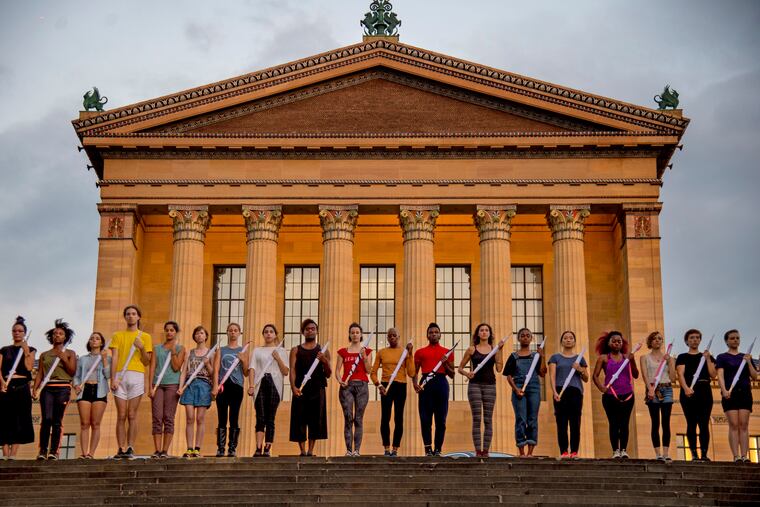Philadelphia Museum of Art performance will be a funeral for weapons in a city of violence
Israeli-born artist Yael Bartana asks a simple, impossible question: What if we buried all of our weapons?

In the Quaker City of Brotherly Love, men and women, boys and girls, have been gunned down everywhere.
They've died on the streets of Center City and West Philadelphia and all other neighborhoods.
People have left their peaceful metropolis to die in the valleys of Afghanistan and the rubbled cities of Syria. They have died in the Battle of Ấp Bắc, the Battle of Bloody Ridge, the Battles of D-Day, the Battle of Belleau Wood, the Battle of Gettysburg, and back and back in time to the battles of Germantown, Brandywine, Trenton, and before.
So many deaths.
For Israeli-born artist Yael Bartana, the tens of thousands of deaths have a cold finality. But they also represent, perhaps, a beginning. What if the men and women and boys and girls said, "Enough!" What if the guns and the rifles were dispatched and the whole apparatus of killing was itself entombed? What if?
Bartana's Bury Our Weapons, Not Our Bodies! enacts this utopian idea in a performance that invites participation. Beginning at 1 p.m. in Washington Square on Saturday, 40 dancers and 70 volunteer performers will gather and wend their way to Independence Mall, arriving at 2 p.m.
The dancers will carry prop guns, the volunteers will carry black and white shields that double as masks. Anyone can join the funeral procession and carry a white flag.
At Independence Mall, speakers, including war veterans, will deliver personal statements on the meaning of the life of violence and the death of violence.
The performance will then shift to the Philadelphia Museum of Art's Reilly Memorial, on the river side of the great neoclassical building, where a funeral will be held at 4 p.m.
Dancers will move down the steps in ritual coordination. Coffins will be arrayed at the bottom. Each performer will shout the name of his or her doomed weapon – "AR-15!" "AK-47!" "Shotgun!" – and lower it into a coffin.
The weapons will then be dispatched to Laurel Hill Cemetery, where they will be buried in the historic graveyard, near the tombs of Union Gen. George Meade and Confederate Gen. John C. Pemberton, famous masters of state-sanctioned killing.
The performance is inspired by the work of Israeli dance composer Noa Eshkol (1924–2007), particularly Eshkol's 1953 performance at Kibbutz Lohamei HaGeta'ot (the Ghetto Fighters' Kibbutz), commissioned in memorial of the 10th anniversary of the Warsaw Ghetto Uprising. The movements are composed by Mor Bashan and Ruti Sela of the Noa Eshkol Chamber Dance Group.
Bartana sees the funeral for weapons, with its ritualistic cadences and movements, as an echo of military burial ceremonies, or as "an act of protest."
It is also a "what if" concept that directly relates to the history of Philadelphia as "the birthplace of democracy."
The area of Independence Mall is "supercharged," she said, crammed with "many different histories, many different graveyards." The ghosts of violence hover everywhere, and the bones of the dead lie beneath Washington Square and Independence Mall, quite literally.
"It makes sense to communicate with the ghosts of violence," Bartana said.
Bartana's film trilogy, And Europe Will Be Stunned, also opens at the Art Museum Saturday. The three films chronicle the rise and death of the Jewish Renaissance Movement in Poland, a fictional group with the radical vision of a Jewish return to Poland.
Amanda Sroka, the Art Museum's assistant curator of contemporary art, elaborated on the notion of fictional alternative realities, an idea in the air in the United States in recent times.
"With the [film] trilogy, you did this moment of what if," Sroka said to Bartana as the two sat chatting in the cafeteria of the Art Museum, shortly before a Wednesday evening performance rehearsal.
"With the performance, it's 'What if we buried these weapons, what if we all buried our weapons in the ground? What if, in the case of the [film] trilogy, 3.3 million Jews returned to Poland?' These questions really challenge us through … political imagination – they kind of jerk us into another reality."
Bartana said there is a "culture of reenactments" in America – re-creation of events and figures from U.S. history.
"I'm interested in pre-enactments," she said, "something that did not happen. We are creating a possible future of the U.S. when everybody is burying their weapons."
The film trilogy will be on view in the Perelman Building through Jan. 1. The art museum and the Walker Center of Art in Minneapolis have acquired the films.
Both the performance and film trilogy use and manipulate symbols, obviously, whether the symbol is the ritual of the military funeral or the literal symbols of the Zionist movement.
But all returns to what if.
"We are creating a utopian moment," Bartana said.